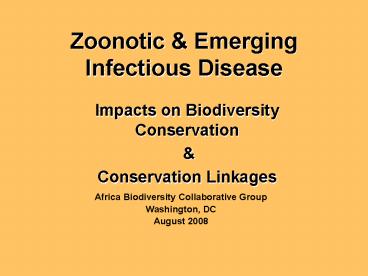Zoonotic - PowerPoint PPT Presentation
1 / 16
Title:
Zoonotic
Description:
61% of all infectious organisms known to be pathogenic to ... Simian Foamy virus. Human-Livestock-Wildlife interface shapes the dynamics of disease emergence ... – PowerPoint PPT presentation
Number of Views:899
Avg rating:3.0/5.0
Title: Zoonotic
1
Zoonotic Emerging Infectious Disease
- Impacts on Biodiversity Conservation
- Conservation Linkages
Africa Biodiversity Collaborative
Group Washington, DC August 2008
2
Overview
- Background
- Impacts on Biodiversity Conservation
- Threat Reduction Strategies What the
Conservation Community Can Do
3
- 61 of all infectious organisms known to be
pathogenic to humans are zoonotic, readily
transmissible between human and animal
populations - Approximately 75 of recent emerging infectious
diseases have been zoonoses
Avian Influenza Virus
Ebola Virus
Anthrax
4
Emerging or Reemerging Zoonoses in Africa
- Highly Pathogenic Avian Influenza virus (H5N1)
- Ebola virus
- Monkeypox virus
- Bovine Tuberculosis (Mycobacterium tuberculosis)
- Rift Valley fever virus
- Simian Foamy virus
5
- Human-Livestock-Wildlife interface shapes the
dynamics of disease emergence - Factors Contributing to Disease Emergence
- Deforestation, land degradation, climate change
and loss of wildlife habitat - Rising demand for animal protein
- Expected to increase 50 by 2020 (IFPRI)
- Global trade in wildlife
- gt 1 billion incidents of contact annually amongst
humans, domestic animals and wildlife (Karesh WB,
et. al.. Emerging Infectious Diseases. July 2005)
6
Emerging Disease Impacts on Biodiversity
Conservation
- Animal populations are under heightened pressure
to survive, and further loss of biodiversity is
highly probable. (One Health Initiative Task
Force Report. JAVMA. July 2008) - Impacts on Wildlife
- Impacts on Public Health
- Impacts on Livelihoods, Food Security and
Sustainable Economic Development
7
Impacts on Wildlife
- Direct threats to wildlife health
- Rabies in Serengeti National Parks African wild
dog (Lycaon pictus) population - Potential spillback to domestic animal human
populations
- May 2005, Qinghai Lake Nature Reserve (China)
H5N1 avian influenza outbreak - estimates of 5-10 of worlds population of
Bar-headed Geese (Anser indicus) lost to AI virus
8
Impacts on Wildlife
- Losses attributable to the bushmeat trade
- Livestock lost to disease may push higher rates
of bushmeat consumption - Bushmeat hunting may facilitate disease emergence
N. Kumpel
A.Asamoah/GWS
9
Impacts on Wildlife
- Loss of biodiversity
- Central Africa Bushmeat industry accounts loss
of gt579 million animals annually (Karesh et al.
2005) - Infectious disease has the potential to
- Push already threatened species rapidly toward
local population extinction - Reduce genetic variability essential for
population health - Provoke follow-on effects in interdependent
species within a microenvironment - Incite fear or panic leading to calls for
wildlife culls or habitat destruction as a
disease control strategy
10
Impacts on Public Health
- Zoonotic threats to human health
- Risks attributable to
- Livestock-dependent livelihoods
- Proximity to wildlife/wildlife products
- Costs
- Loss of income generating capacity
- Inability to pay school fees secure dietary
staples - Transport to a health care facility/clinic
- Medical treatment
- Caretaking demands upon family
- Possibility of disease transmission to family
11
Impacts on Public Health
- Loss of conservation capacity
- Human resources already weakened by AIDS are
particularly vulnerable - Potential loss of local and indigenous knowledge,
skills and experience - Costs of disease control measures
- Livestock culls, quarantines, diagnostic tests,
vaccination - Represent resources unavailable to conservation
initiatives
12
Impacts on Livelihoods, Food Security and
Economic Development
- Loss of income and threatened food security
- 70 of worlds rural poor--in Africa 200
million--derive their livelihoods from livestock - Loss of livestock/reduced livestock productivity
threatens income generation protein
availability - Impacts along the market chain livestock
holders, traders, fodder producers, butchers,
market vendors - Intensified land utilization pressure on
natural resources charcoal making/timber,
bushmeat, fishing, agricultural encroachment
along protected areas
13
HPAI Poultry Consumption
- Loss of Domestic Poultry
- Poultry illness/loss of productivity
- Poultry death
- Poultry culls
Poultry Consumption Fears
Kenya 30 million chickens, 80 raised
traditionally by small holders 2-3
chickens/rural household
- Loss of income
- Inability to pay for school fees, medicine,
dietary staples - Loss of protein nutrition
Tanzania 27 million chickens, 70 raised
traditionally by small holders
14
Impacts on Economic Development
- Restricted economic growth
- Export embargoes/trade restrictions
- Potential losses to the commercial livestock
industry - Pandemic emergence threats
- Projected Pandemic Influenza Costs
- 10-180 million deaths worldwide
- Economic Impact 2-3.1 of global GDP (gt2
trillion USD) (World Bank) - Threats to sustainable ecotourism initiatives
- Kenya Tanzania wildlife based ecotourism
generates half a billion USD annually (Chomel B,
et al. Emerging Infectious Diseases. January
2007) - Community revenue sharing/park budgets threatened
by disease-induced tourism declines
15
Threat Reduction Strategies
- Conservation of Wildlife Habitat
- Disease impact assessments prior to resource
extraction - Disease Surveillance and Rapid Diagnosis
- Wild Bird Global Avian Influenza Network for
Surveillance (GAINS) - Expand successful community-based disease
surveillance programs - UKs RADAR (Rapid Analysis and Detection of
Animal Related Risks) - Education, Training, and Outreach
- Risks associated with the bushmeat trade
- Personal biosafety
- Media outreach
- Promote sound (livestock vaccination/behavior
change) vs. unsound (wildlife culls) disease
control strategies
16
Threat Reduction Strategies
- Preparedness and Response Planning
- Design contingency plans to protect staff and
conservation capacity in the event of a disease
outbreak/pandemic event - Food Security
- Encourage diversified sourcing of dietary protein
- Engaging private sector for low-cost commercial
solutions - Alternative Livelihoods Opportunities and
Economic Stability - Diversified livestock/agricultural
production/social service businesses - Broad-based programs addressing poverty,
malnutrition and bolstering public health (clean
drinking water) improved resiliency to disease
events reduced pressure on wildlife/land/natural
resources - Multi-Disciplinary Approach































